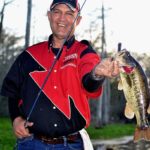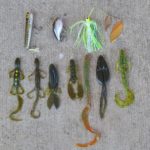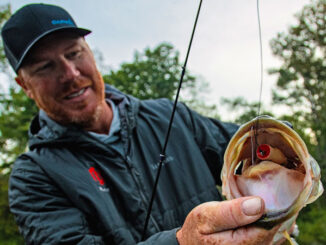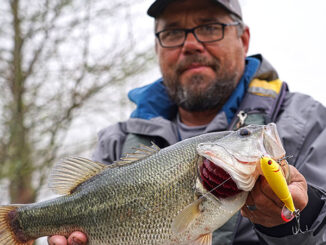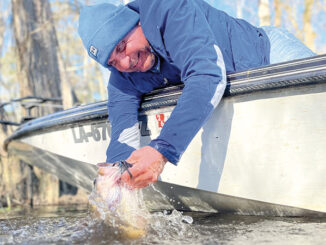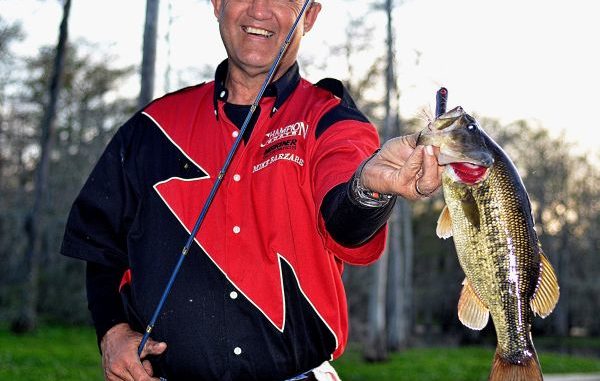
Chicot Lake has produced some huge bass, but last year the slot limit was finally dropped. That means the limit is now 10 fish of any size — and there are plenty to be caught. Here’s how to up your fishing odds.
It’s not often when you get Chicot Lake mostly to yourself. But Turkey Creek’s Mike Barzare and I found an afternoon last spring when we encountered only a few boats on the Evangeline Parish fishery.
A week earlier, the 14- to 17-inch slot limit for largemouths had been removed and the limit now reflected statewide regulations — 10 bass with no length restrictions whatsoever.
As a result, the South Landing parking lot and the hill to the south were filled with vehicles and trailers for a few days immediately following the changes.
But by the time Barzare and I made it to the lake, the initial rush was over, and the lake was seeing less boat traffic and fishing pressure.
“It’s a beautiful day for fishing Chicot,” the 61-year-old Barzare said. “Although we have a high, I know a few places holding some fish.”
We began fishing just north of the Conservation Lodge Cove on the northwestern end. Barzare started by casting Storm Chug Bugs near standing cypress trees and laydowns.
His topwater disappeared on the first point to which he cast.
The bass struggling on the end of Bazare’s line was about 15 inches long, and usually we would have the measuring stick out to check.
Not this time, and Barzare and I admitted to feeling weird about it.
After all, the 14- to 17-inch slot restriction on Chicot’s largemouths had stood for 23 years. And Barzare was holding a bass that shortly before would have been a slot fish but could now be legally placed in the livewell.
We eventually headed south to Turtle Island Cove and the Branch. We didn’t even have a bite in Turtle Island, but the Branch did yield a few more bass on the Chug Bug.
When we reached the Pine Island area, the sun was really warming up the waters, and Barzare and I switched to 6-inch Mister Twister Super Lizards and Zoom Lizards in watermelon candy.
Bass in the 12- to 16-inch range hit these plastics willingly enough when the lures were worked along points and within laydowns.
By lunch we had caught and released 12 bass.
All in all, it was a great day to be fishing bass on Chicot Lake. As most local and visiting anglers know this lake is more than just finicky when delivering bass to anglers’ offerings.
There are many more times of pitiful catches than plenty.
Before its 1,642 acres were impounded in 1942, Chicot Lake was an immense cypress-tupelo swamp. Today, the banks are still charactereized by standing cypress and tupelo clusters, and dense hardwoods accent a few of its coves.
If only the bass catching was as magnificent as the lake’s beauty. Let’s just say it can be tough.
But Barzare has fished Chicot Lake for half a century, and during that time he’s learned a lot about how to up his odds of success.
Let’s take one of his trips last March as an example of what can happen on a great day on Chicot Lake: The angler was prefishing for a tournament by casting crankbaits in the Branch area.
“I was fishing cypress trees and rotten stumps, and having a great time catching fish,” Barzare said. “I had taken a 6-pounder, along with another weighing 5 ½ pounds, in the morning.”
The crankbait bite tapered off as the sun warmed the waters, so he turned to Zoom Brush Hogs as he made his way toward the Pine Island area and mid-lake.
“There, I caught 3- and 4-pounders and missed five or six other fish,” he said. “I was so excited I called my son, as I had figured my best five would have been near 20 pounds.
“It was just an astronomical day on Chicot.”
Two weeks later, he placed third in the tournament — but didn’t come close to that 20-pound stringer.
He has translated his knowledge into a guide service, where he often put clients outside the slot.
“I remember one great day shared with a couple of anglers from Hammond,” Barzare said. “We had 12 keepers, and nine of those were above the slot.”
To date, Barzare’s largest Chicot Lake bass tips the scales at 9 pounds, and the angler has taken many bass weighing 6 to 8 pounds.
But how does Barzare find such finicky Chicot Lake bass on any given day in March and April?
“We’re talking about prespawn and spawning bass then,” Barzare said.
The angler works the northwestern portion of the lake west of the main channel.
“The Branch area is where I would advise anglers to start,” he said. “I would work points in the area starting with crankbaits.
“At midmorning, I will cast Mister Twister Jerk Rats and Zoom Flukes. I would work them by throwing these in 3 to 5 feet of water around cypress trees, laydowns and submerged timber.”
He then fishes the same cover in the Turtle Island area.
According to the angler, sight-fishing for spawning sow bass is rather limited due to weedy and grassy banks, although every now and then a good fish will be spotted on a bed.
But bedding fish are extremely wary because of the fishing pressure — but a few are plucked from the beds each year.
White/chartreuse spinnerbaits worked on points and near the banks also work well until noon, Barzare said.
He remains in the same areas as April approaches, using Jerk Rats and Magnum Sinsations to fish patches of hyacinths, alligator weed and water primrose.
If he doesn’t get a strike while twitching the lures across the top of the vegetation, Barzare allows the lures to fall down the edges.
As for the rest of his tackle, Barzare prefers FINS braid when throwing Jerk Rats and Magnum Sinsations. When casting Chug Bugs and spinnerbaits, the angler will have Trilene Big Game monofilament attached to either Lews BB1 or Abu Garcia reels.
His rods of choice include PRS Customs and St. Croix rods.
Barzare can be reached for information or guide service on Chicot Lake and nearby Miller’s Lake at 337-230-5014.
